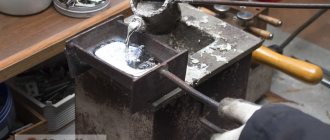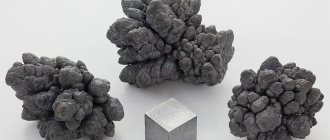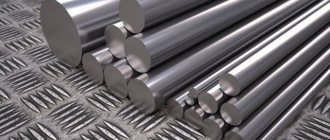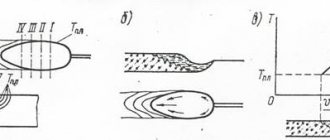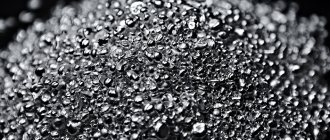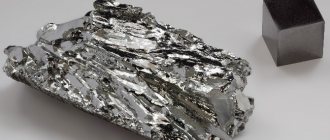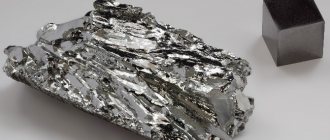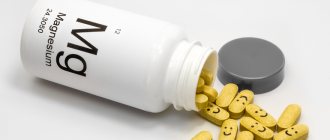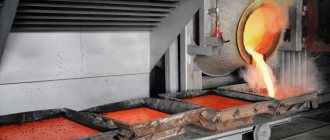Lead, designated by the symbol Pb (plumbum), is one of those metals that have been known to mankind for a long time. Lead finds in the form of beads date back to 6000 BC. In Ancient Rome, lead water pipes and dishes were made until the toxicity of lead compounds was proven.
Now it is a strategic metal, it is used in the defense industry. Explosives and current sources are made from it. Lead is inexpensive to produce and the metal is extracted from naturally occurring minerals. First, a rough alloy is obtained, then a pure one.
It is not difficult to melt lead at home; the melting point of lead and its alloys is not higher than +330–450°C, and that of solders is not higher than +230°C. The metal is not subject to corrosion damage, is ductile, malleable, and is used in many industrial fields. It is used to make household items, fishing gear, and do-it-yourself solders by filling molds with liquid lead.
History of the discovery of lead
The most ancient artifacts made by man from lead are considered to be ancient Egyptian figurines about 5 thousand years old, although archaeologists have found more ancient simple products from this metal. The first boom in the use of lead occurred during the Roman Empire, when they began to make water pipes from it and even used it for gastronomic purposes. Already in those years there were suspicions that it could be harmful to health. After the fall of Rome, lead consumption dropped significantly, but the use of the toxic material in water supplies lasted until almost the 20th century in many countries.
The malleable metal was actively used as a connecting material in window frames and roof coverings. With the industrial revolution of the Victorian era, the need for lead increased many times over, and every year new opportunities and applications for lead compounds opened up. Quite quickly, this metal became one of the most important elements necessary for technical progress, and remains so to this day.
Application area
Despite its toxicity, lead is valued for its corrosion resistance and ability to block γ-radiation. It remains indispensable in many industries.
Up to 75% of the resulting lead is used in electrical engineering for battery plates and transformer superconductor systems, power cables. Babbitt - steel alloyed with Pb, has anti-friction properties. Alloys containing tin and cadmium are used for solders.
Plumbum is part of anti-corrosion coatings and dyes. Bullets and shot, printed font, figurines, and sinkers are cast from it. Metal sheets are used to shield X-ray installations, nuclear reactors, and bunkers at landfills. The plates are sewn into aprons, vests, and other protective clothing. Lead plates reduce vibration and seismic shocks. They are used in construction to compact masonry, foundations, and bridge supports. Nitrate is used to produce explosives with high detonation.
Properties of lead
Lead has excellent ductility and malleability, but low tensile strength. The metal is dense and heavy but relatively soft. It melts already at a temperature of 327 0C, which makes working with metal extremely easy. Contains radioactive radiation - for example, a lead sheet only 5 millimeters thick will be impenetrable to X-rays.
In metallurgy and industry, the ability of lead to form alloys with metals that cannot be combined without lead is valued. Resistance to acids (comparable to gold) is used in various manufacturing industries - pipes and containers for transporting acids are made from lead. Combined with low cost, the listed qualities predetermined the areas of use of this unique metal. The picture is spoiled by only one significant drawback - toxicity to humans and the environment.
Main lead ores
Galena is the main source of lead, mentioned in the works of ancient authors. It is characterized by a cubic crystallization structure and a classic “lead” color. It has a metallic luster, but in air it actively reacts with oxygen and becomes dull-matte. Among the impurities, cadmium is noted, a metal valuable for industry.
Cerussite - formed from the weathering of galena, also a valuable source of lead. It is distinguished by its high transparency, which is why it can be easily confused with more valuable species. A couple of centuries ago, powdered cerussite was used as a cosmetic product, and the crystals were cut and traded under the guise of precious stones.
Andorite - stands apart among the numerous ores containing lead, due to its equal silver content, and is mined to obtain both metals. Distributed in Central Asia and mountainous regions of South America.
Crocoite is one of the few lead minerals that has no industrial value or use, but is used as a decorative or collectible item. "Red Lead Ore" has a unique appearance and structure, reminiscent of pressed saffron (from which it gets its name from the French name). Although the mineral was discovered in Russia, in the Urals, and was originally called “Siberian red lead.”
Natural minerals chemical element
There are many mineral formations of lead in nature, but compounds with sulfur are of industrial importance. Lead sulfide PbS (lead scale, galena) is a brittle gray mineral containing up to 87% metal.
In nature, it occurs in the form of a crystalline granular mass. The mineral is mainly concentrated in hydrothermal deposits, where it is found in the form of cubic or octahedral crystals.
In nature, lead can be recognized in ore by granular, shiny growths
The hardness of the formation is 2.5–2.7 on the Mohs scale, density 7.5. When struck with a hammer, the mineral formation breaks down into small cubes with stepped ledges. Galena is distinguished by perfect cleavage in 3 directions along the faces of the cube.
Companions of lead sulfide are the following minerals:
- quartz;
- sphalerite;
- azurite;
- malachite;
- dolomite;
- stibnite;
- chalcopyrite;
- native silver;
- pyrite.
The main lead deposits in Russia are located in the Krasnoyarsk and Primorsky territories, Altai, the Far East, and Buryatia. Large ore reserves are located in many countries of the world and are concentrated in the USA, Canada, Peru, Mexico, and Australia. Lead ore deposits are found in Kazakhstan, China, Bulgaria, Germany, Hungary, Slovenia, and Vietnam.
To a lesser extent, industrial development of oxidized ores, which are composed of lead carbonate (cerussite) and sulfate (anglesite), is carried out. The presence of precious and non-ferrous metals increases the value of ores.
The deposits are developed mainly underground. However, depending on the nature of the formation of deposits, the upper horizons are developed using the open method.
Main lead producing countries
The lion's share of global lead production comes from the European Union, but it's worth noting that they get 60% of the metal from recycling rather than direct mining - a trend that is gaining popularity in other countries. The next 3 places are shared by the USA, Russia and China, with small gaps from each other. In the post-Soviet space, Ukraine and Kazakhstan traditionally demonstrate high levels of lead production. The latter also has one of the world's largest proven reserves of this metal.
Lead oxide hydrate Pb(OH)2
Formed by the action of alkalis on soluble salts of divalent lead. It is amphoteric in nature and dissolves in acids to form divalent lead salts, and in alkalis to form salts called plumbites:
Pb(OH)2 + 2NaOH = Na2PbO2 (sodium plumbite) + 2H2O
However, it is more likely that when dissolved in alkalis, hydroxy salts are formed according to the equation:
Pb(OH)2 + NaOH = Na[Pb(OH)3]
Industrial production
From ore containing lead (most often it is galena, a sulfide class mineral), at the first stage a concentrate of 50-70% is obtained. To do this, the raw materials are crushed and mixed with oil and water. The sulfide compounds are coated in oil and retained on the surface of the solution, while the by-product rock precipitates. This method is called flotation.
Next, from the resulting concentrate it is necessary to obtain werkbley (the name of rough lead in metallurgy, the content of the target metal is approximately 90%). First, thermal agglomeration of the concentrate is carried out, and the mass is significantly enriched with oxygen. After this, lead is reduced from the oxide in the waterjacket shaft.
At the last stage, pure lead is obtained. To remove a specific metal and other impurities from an alloy, a separate procedure is required:
- Taking advantage of the difference in melting temperature, metals that are more refractory than lead (for example, copper) are separated. The process is called zeigerization.
- Arsenic and antimony are removed by alkali refining.
- Zinc foam allows you to highlight some precious metals.
- Reactions of calcium compounds help remove bismuth from the composition.
The final set of necessary processes depends on the degree of contamination of the rock. The result is lead with an impurity content of about 0.1% or less.
Lead Poisoning Symptoms
Lead poisoning can be difficult to detect initially—even healthy people can have high levels of lead in their blood. Signs and symptoms usually do not appear until dangerous amounts have accumulated.
Signs and symptoms of poisoning may include:
- High blood pressure.
- Joint and muscle pain.
- Problems with memory or concentration.
- Headache.
- Abdominal pain.
- Mood disorders.
- Low sperm count and abnormal sperm.
- Miscarriage, stillbirth or premature birth in pregnant women.
Employers have a responsibility to protect workers from exposure to inorganic lead. The employer must also initiate specific compliance actions, including blood lead testing for exposed employees.
The most important lead compounds and their applications
Lead, being a fusible heavy metal, has been used since ancient times to this day for the manufacture of ammunition, including for civilian purposes. Another feature of lead is its ability to absorb radiation, which has led to its widespread use in nuclear energy and medical technology. But much more extensive possibilities are opened up by various compounds of lead with other substances and metal alloys. Without them it is difficult to imagine any branch of human activity. The chemical industry and agriculture, military science and batteries, mechanical engineering and lithography, geology and much more - all these areas involve lead compounds.
Recommendations
- Polyansky 1986С. 14–15.
- ^ a b c d
Pauling, Linus (1947).
General chemistry
. W. H. Freeman. ISBN 978-0-486-65622-9. - ^ a bc Brady
, James E.;
Holum, John R. (1996). Descriptive Chemistry of the Elements
. John Wiley and Sons. ISBN 978-0-471-13557-9. - Windholz, Martha (1976). Merck Chemical and Drug Index, 9th ed., Monograph 8393
. Merck. ISBN 978-0-911910-26-1. - Polyansky 1986, paragraph 21.
- ^ a b c
Polyansky 1986, paragraph 22. - ^ a b
Polyansky 1986, p. 28. - ^ a b
Polyansky 1986, p. 32. - Polyansky 1986, paragraph 33.
- Polyansky 1986, paragraph 34.
- Zuckerman, J. J.; Hagen, A. P. (1989). Inorganic reactions and methods, formation of bonds with halogens.
. John Wiley and Sons. item 426. ISBN 978-0-471-18656-4. - ^ a b c d e
Puigdomenech, Ignasi (2004).
Hydra/Medusa Chemical Equilibrium Database and Plotting Software
. KTH Royal Institute of Technology. Archived from the original on September 29, 2007. - Ward, CH.; Hlousek, Douglas A.; Phillips, Thomas A.; Lowe, Donald F. (2000). Repairing impact berms at a shooting range
. CRC Press. ISBN 1566704626. - ^ a b
Polyansky 1986, p. 43. - Windholz, Martha (1976). Merck Chemical and Drug Index, 9th ed., Monograph 8393
. Merck. ISBN 0-911910-26-3. - ^ a b
Polyansky 1986, p. 44.
Lead Babbitts
These are alloys of lead in order to give it better wear resistance and reduce the coefficient of friction. A number of metals can be used as alloying additives - copper, nickel, calcium and others. Lead-based babbits have proven themselves in the production of bearings for various purposes:
- carriages and electric locomotives;
- rotating parts of diesel engines;
- heavy industry;
- complex technology and automotive industry.
Since 1847, lead babbits have been an integral part of Russian industry. Among the disadvantages, quite rapid destruction from heavy loads is noted, so the durability of units using such alloys strongly depends on the quality of the metal of the bearing housing. The thicker and stronger it is, the more voluminous the babbitt layer can be made, and therefore increase the service life of the product.
Melting process
The following is used as a heat source for melting scrap:
- a fire, with a smelter stand placed above it;
- blowtorch, it is fixed in a stationary position;
- a gas burner, with which the metal is heated both from below and from above, alternately;
- kitchen stove (gas or electric).
Important!
The container is installed so that the flames do not extend beyond the bottom area.
Lead smelting begins with a preparatory stage: you need to prepare a smelting container and grind the scrap. It is cleaned of impurities, possible moisture, and contaminants. Then cut into small pieces with a knife or metal scissors. It is difficult to break lead pieces; they bend well. The smaller the scrap, the faster it will melt. It is recommended to gradually add it to the melting tank. When the pieces are loaded into the melt, the risk of the melt overheating to the volatility point is reduced. You should not heat the pieces to a reddish tint, this is a signal that they are forming toxic volatile compounds.
Plumbates
Calcium orthoplumbate is a faint orange crystalline substance. Throughout the 20th century it was used in chemistry and medicine as a source for easily producing pure oxygen, which is released when heated. This was also facilitated by the ease of synthesis of the substance itself - it is obtained by calcining lead oxide and calcium carbonate. Further success was hampered only by the toxicity of the process.
The following group of plumbates is used in the chemical production of complex lead compounds:
- sodium metaplumbate;
- ammonium hexachloroplumbate;
- hexachloroval acid;
- potassium triodoplumbate.
All of them easily decompose, dissolve in water and react with other compounds. This makes them an indispensable raw material and catalyst for many processes, as well as a basic component in the production of some complex substances.
Lead oxides
Lead oxide (PbO) is a slightly water-soluble crystal, yellowish or scarlet in color. It is used in the manufacture of glass products, crystal, glossy enamels and varnishes. A common component of lead-acid batteries. Raw materials for other compounds.
Lead dioxide is a toxic brown powder with a characteristic odor. An important catalyst for many chemical reactions and processes, no research laboratory can do without this substance. When added to paints, it speeds up the drying process, which is actively used by manufacturers of paint and varnish products.
Lead tetroxide, also known as lead tetroxide, is an insoluble orange-red powder. Rare, but found in nature. It is widely used as a pigment for anti-corrosion coatings in the construction of buildings, bridges, ships and other large objects. When some parts of an unfinished ship appear “rusty”, this is the effect of red lead in the composition of protective emulsions.
Separately, it is worth mentioning PZT - an oxide of a compound of lead zirconates and lead titanates. A most valuable substance that can induce a charge when subjected to deformation, or produce a reverse reaction - deform under the influence of current. Without it, it would be impossible to create many types of electroacoustic devices and capacitors.
Lead salts
Lead nitrate is prepared by dissolving lead plates in nitric acid. Known for over 400 years, commercial production began only in the 19th century. In a calm state it is a colorless powder, highly soluble in water. Used as a reaction suppressor in nylon polymers and an improver in gold cyanidation. It was used for some time as a pesticide and oxidizing agent in organic chemistry, but due to its severe toxicity, its use has virtually disappeared. Currently it serves as a raw material for the production of more complex compounds of lead and other substances.
Lead azide is a salt of hydronitrous acid and is extremely poisonous. A common explosive used as an initiator (in detonators). Being very sensitive to physical and temperature effects, it requires special precautions when handling.
Lead chloride is obtained by reaction with hydrochloric acid. Occasionally occurs in nature (cottunite) with a relatively small amount of impurities. At the same time, it has moderate radioactivity; this leads some scientists to think about the meteorite origin of the mineral. Widely used in batteries as a cathode.
Lead sulfate is also known as lead sulfate. Poisonous and dangerous to human health. Often found in nature (anglesite). It is synthesized as a by-product during reactions in batteries and is one of the main pollutants. It has found application in industry as a pigmenting material.
Human exposure to lead
The most common culprit of heavy metal poisoning is lead. For a long time, lead additives were used to lead gasoline, which led to severe air pollution in large cities. Today, the use of lead to increase the octane number of fuel is prohibited almost throughout the world (in the Russian Federation - since 2002). Other possible sources of poisoning:
- industrial emissions;
- agricultural products contaminated with heavy metals;
- household items containing lead;
- work in hazardous industries.
Once in the body, lead has a strong toxic effect. Metal poisoning in childhood is especially dangerous. Lead intoxication in a child leads to delays in physical and mental development, and cognitive impairment can manifest itself throughout subsequent life. In adults, constant contact with lead or regular inhalation of its vapor causes chronic poisoning, impairs brain function and significantly increases the likelihood of serious diseases, including cancer.
How to melt lead
In factories, the following are used as melting tanks:
- special crucibles made of refractory ceramics or refractory metals; they are placed in electric furnaces that provide the necessary thermal conditions;
- heating baths, they are equipped with built-in shades, maintain the required temperature of the metal around the entire perimeter.
You can melt lead yourself at home, in the yard, garage or workshop in a tin can, it will replace the crucible. On one side of the tin a groove is made for pouring metal into the mold. The edges of the form are folded so that they are securely fixed in the clamp. Instead of tacks, it is more reliable to hold the hot container with pliers; the melting pot will not burn your hands while filling the mold.
You can use old household utensils to melt lead scrap: pots, pans, stainless or enamel kettles, or other heat-resistant cookware. The slag layer is removed with a special spoon with a long handle. This is done immediately before pouring the metal into prepared molds.
